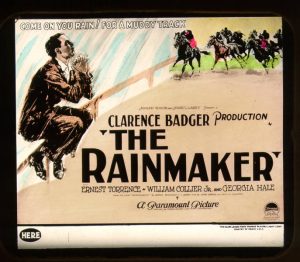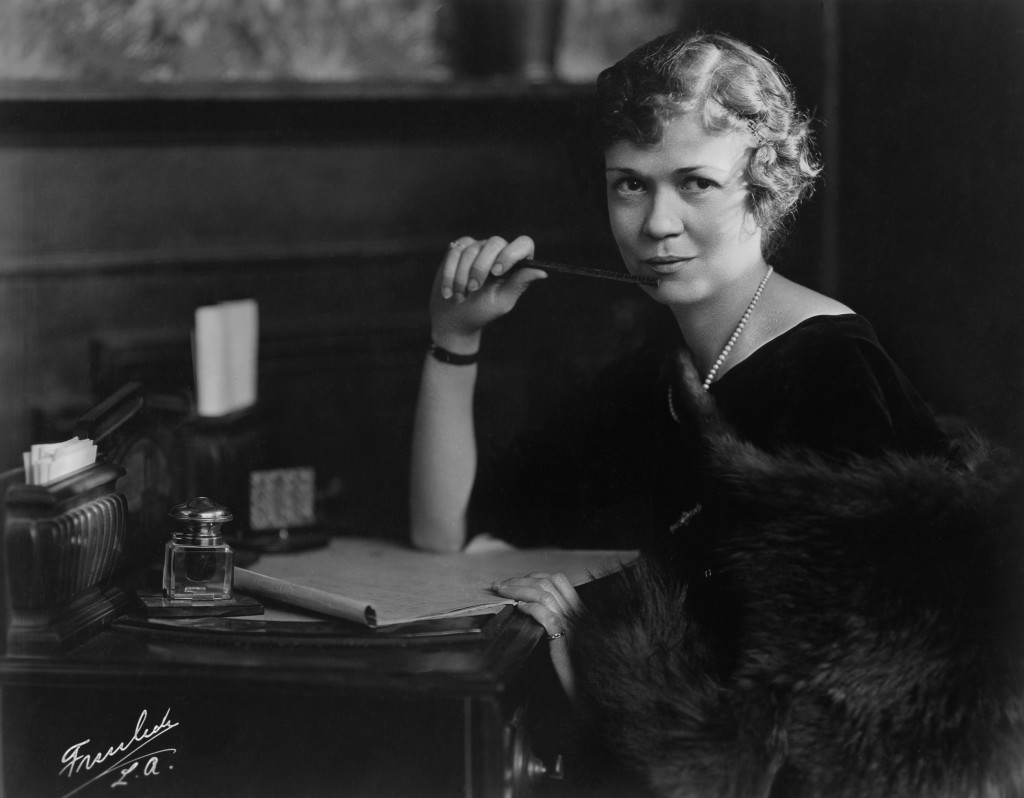by
Annie Berke
The life and times of Hope Loring, scenarist and wife of her collaborator, writer-producer Louis “Buddy” Lighton, are mentioned in the margins of Hollywood history. Loring, however, cuts a colorful, memorable figure in the few texts that mention her. Elia Kazan, in his autobiography, deems her petite and asexual (252), and W. C. Fields reportedly did not like this “fast-talking” woman (Curtis 199). However, in her autobiography, screenwriter Frederica Sagor Maas gives us more insight into the couple’s marriage and working relationship than gossip columnists would dare:
Hope Loring, a manipulator and fast talker… had a heart condition, which she played up to the hilt. It won her B. P. [Ben Schulberg]’s sympathy and helped her control her Buddy. She was the brains of their writing partnership. He needed her and could not afford to lose her (149).
But while some, like Maas, could not abide her, Loring had allies in the film community. One was Mary Pickford, who in 1937 married Buddy Rogers (Carey 217), at what as one society page referred to as “Hope Loring’s home” (Kendall A7). Loring not only wrote for some of the top stars in Hollywood, such as Pickford, Clara Bow, even Gary Cooper, but was written about along with them.
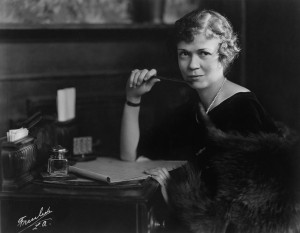
Hope Loring at her desk. Courtesy of the Academy of Motion Picture Arts and Sciences, Margaret Herrick Library.
Hope Loring’s early life proves something of a mystery that we must puzzle together to produce a time line. From a 1919 article in the Moving Picture World, we learn that she was born in Barcelona to an Irish father and Spanish mother, but was orphaned as a baby after her parents were killed in a car accident. Hope’s aunt moved Hope to England at two years old and to the United States at the age of five (n.p.). Hope’s coming-of-age is not well-documented, but an item in the Los Angeles Times society page from 1922 gushes about how Hope Loring the writer “achieved no little fame as a dancer” and, further, that “[i]t was real dancing, not the shimmy, jazz or any of the numerous flapper varieties” (“Writes” III31). According to a 1925 Los Angeles Times article that provides us with the most biographical detail, before she arrived in Los Angeles, she worked in Florida as a drama critic and as a film extra in New York (Williams 26). Perhaps during these years Loring was loathe to reveal her true age to journalists, though a voting census from 1916 has a “Hope Loring” already registered in Los Angeles county (she will be registered in this county up through 1942), meaning that if she was at least twenty-one in 1916, she would have been in her thirties by 1925. Furthermore, a New York Times article from 1914 reports the scandal of one “Hope Loring,” a young dancer with a small child bringing suit against her homicidal jilted lover (3). One wonders if this Loring is the same woman who would later become a Hollywood insider. The parallels are striking—both the plaintiff in the case and the screenwriter were single mothers. The finding aid for the Lighton Family Papers at the University of Arkansas-Fayetteville states that the Patricia Lighton who survived her mother is Loring’s daughter from a previous marriage. Maas confirms that Loring was on her second marriage with Lighton (Maas 149), and Kazan maintains that Lighton had no children (Kazan 253).
The Lighton Family Papers at the University of Arkansas-Fayetteville not only contain Loring and Lighton’s 1920 marriage announcement, but many of her husband’s notes and papers. Loring is mentioned in a few select documents, perhaps the most illuminating of which is a letter from William to Laura Lighton. Louis’s father William writes to his wife on Monday, April 19, describing Louis and Hope’s impromptu City Hall wedding that had occurred that very day. In his letter, Mr. Lighton praises Loring’s creative gifts and “practical genius,” and, tellingly, says that “her work and his will be together. She has helped him beyond telling in giving him a settled confidence in himself.”
In the years prior to their 1920 marriage, Loring had accrued scenarist credits on such films as A Society Sensation (1918) and Lure of the Circus (1918–1919). She was also working at Universal Pictures as the head of the serial and short reel department. Although she was only beginning her Hollywood career, news about her had already been picked up by local entertainment and gossip columnists. In 1918, a piece in the Atlanta Constitution runs: “Hope Loring, that clever young miss who turns novels into photo dramas, believes in living up to her name. On the door of her office at Universal City she has reversed that famous line on the entrance to Hades by printing ‘Who enters here finds hope’” (C7).
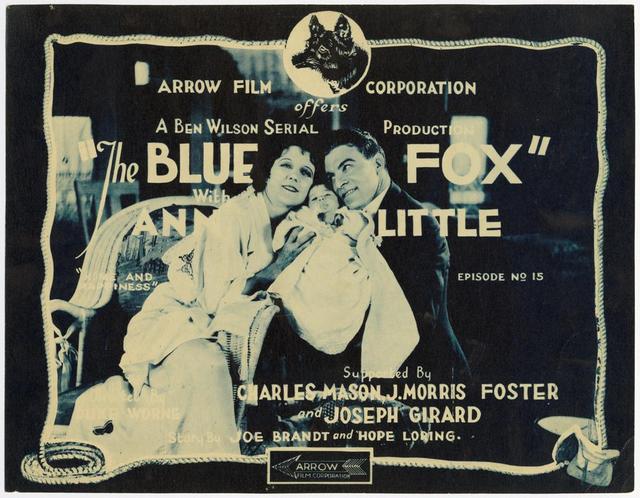
Lantern slide, The Blue Fox (1921), Hope Loring (w). Courtesy of Bison Archives.
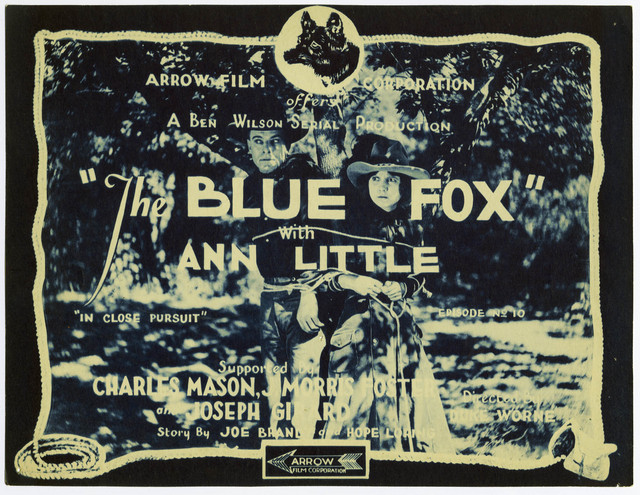
Lantern slide, The Blue Fox (1921), Hope Loring (w). Courtesy of the Museum of the Moving Image.
Hope and Louis struggled to succeed in the early years of their marriage. We know this at least from Maas’s description that they began their married life in a studio apartment on Fairfax Avenue and Sunset Boulevard, riding the bus because they didn’t have money for a car. In her estimation, they were “a couple of mediocre writers on the low end of the totem pole” (149). By the end of 1920, Loring had left her responsible job at Universal Pictures, then working under General Manager Isadore Bornstein, which we know from the Los Angeles Times headline “Hope Loring Resigns.” Not surprisingly, the article mentions that after her honeymoon, Loring would continue to write feature pictures on a freelance basis (III4). The couple would go on to collaborate on at least thirty feature films.
Journalists of the period were always interested in reporting on creative couples, and writers in particular, paying special attention to the way in which the couple balanced domestic and professional duties. In addition to the most visible husband-wife writer teams such as Anita Loos and John Emerson, there were Mr. and Mrs. George Randolph Chester (Lucille Chester), Agnes Christine Johnston and Frank Mitchell, Sarah Y. Mason and Victor Heerman, Bess Meredyth and Wilfred Lucas, among others. The Louis Lighton and Hope Loring collaboration was one of the longest. A Los Angeles Times piece from 1925 titled “Silence Being Golden, Two Scenarists Work Out Own Ideas Without Conference” describes their custom of each buying the other a gift after they finished a screenplay. In this same piece, the author sums up the couple’s routine, with the separateness of their tasks mirroring the ideal household in which man and wife each focused on their own circumscribed responsibilities: “Miss Loring writes a pictorial synopsis of the story, just as she visualizes it on the screen. Lighton writes his version…. Not a word of conversation relative to the story passes between the coauthors until each has read the other’s synopsis. Then, in their own words, “the fireworks start” (C28).
Additionally, a 1925 article entitled “Loring-Lighton Scenario Team Combines Work With Romance” contains Loring’s screenwriting method and philosophy, laid out in three points. First, “the business of writing must be learned.” Second, “get practical experience,” and third, consider budget. She explains, with reference to what she learned as a supervisor at Universal, that writing an expensive sequence “appears to me to be criminal” (Williams 26).
Loring worked on some of the most popular and successful vehicles of her time—including It (1927), an adaptation of Elinor Glyn’s popular book, and Wings (1927), which won the Academy of Motion Picture Arts and Sciences award that year for Best Picture. Her final credit was as a contributing writer on Once a Sinner (1931). Lighton would go on to produce Elia Kazan’s A Tree Grows in Brooklyn (1945) (Kazan 233) and films starring James Stewart, Orson Welles, and Rex Harrison, for instance, in the starring role in Anna and the King of Siam (1946). The couple eventually retired to Mallorca, Spain. Loring died in 1959 and her husband four years later.
Bibliography
1910 Los Angeles Voting Registration (as Hope Loring). California, Voter Registrations, 1900-1968 [online database]. https://www.ancestry.com/search/collections/cavoterrosetta/
1940 Los Angeles Voting Registration (as Hope Lighton). California, Voter Registrations, 1900-1968 [online database]. https://www.ancestry.com/search/collections/cavoterrosetta/
1942 Los Angeles Voting Registration (as Hope Lighton). California, Voter Registrations, 1900-1968 [online database]. https://www.ancestry.com/search/collections/cavoterrosetta/
“And The Greatest of These is Hope: Hope Loring, Scenarist, Confessing Startlingly on Eve of Going Abroad on New Universal Serial.” Moving Picture World (28 June 1919): n.p.
Carey, Gary. Doug & Mary: a biography of Douglas Fairbanks and Mary Pickford. New York: E.P. Dutton, 1977.
Curtis, James. W.C. Fields: A Biography. New York: Alfred A. Knopf, 2003.
“Hope Loring Resigns.” Los Angeles Times (6 June 1920): III4.
Kazan, Elia. Elia Kazan: A Life. New York: Da Capo Press, 1997.
Kendall, Read. “Around and About in Hollywood.” Los Angeles Times (19 June 1937): A7.
Lighton, William. Letter to Laura Lighton. 19 April 1920. (MC 779, Box 4, File 1). Lighton Family Papers. University of Arkansas Libraries, Special Collections.
“LOCKED HER IN TO DIE WITH HIM, GIRL SAYS; Hope Loring, Dancer, Causes Arrest of Derby Crandall, Jr., for Assault.” New York Times (20 July 1914): 3.
Maas, Frederica Sagor. The Shocking Miss Pilgrim. Lexington: University Press of Kentucky, 1999.
“Scenarists Will Again Free Lance.” Los Angeles Times (17 May 1925): 30.
“Silence Being Golden, Two Scenarists Work Out Own Ideas Without Conference.” Los Angeles Times (22 Nov. 1925): C28.
“State President State Sponsor.” Atlanta Constitution (1 Sept. 1918): C7.
Wedding announcement. (MC 779, Box 4, File 1). Lighton Family Papers. University of Arkansas Libraries, Special Collections.
“What’s New on Stage and Screen—“ (MC 779, Box 15, File 8). Lighton Family Papers. University of Arkansas Libraries, Special Collections.
Williams, Whitney. “Loring-Lighton Scenario Team Combines Work With Romance.” Los Angeles Times (5 July 1925): 26.
“Writes and Dances” [Display Ad 175 – No Title]. Los Angeles Times (30 July 1922): III31.
Archival Paper Collections:
Lighton Family Papers. University of Arkansas Libraries, Special Collections.
Filmography
A. Archival Filmography: Extant Film Titles:
1. Loring as Screenwriter:
A Society Sensation. Dir.: Paul Powell, sc.: Hope Loring, Paul Powell (Bluebird Photoplays Inc. US 1918) cas.: Carmel Myers, Rudolph Valentino, si, b&w, 16mm.. Archive: UCLA Film & Television Archive.
Lure of the Circus. Dir.: J.P. (Jack) McGowan, sc.: William E. Wing, Hope Loring (Universal Film Mfg. Co., Inc. US 1918-1919) cas: Eddie Polo, Eileen Sedgwick, Molly Malone.
- Chap. 1, “The Big Tent,” si, b&w, 35mm. Archive: Library of Congress.
- Chap. 2, “The Giant’s Leap,” si, b&w, 35mm. Archive: Library of Congress.
- Chap. 3, “Beaten Back,” si, b&w, 35mm. Archive: Library of Congress.
- Chap. 17, “A Race with Time,” si, b&w, 35mm. Archive: Library of Congress.
- Chap. 18, “The Last Trick,” si, b&w, 35mm. Archive: Library of Congress.
- [Unidentified Chapters], si, b&w, 16mm. Archive: UCLA Film & Television Archive, Academy Film Archive.
The False Trail. Dir.: Irving Cummings, sc.: Hope Loring (Irving Cummings Production Co. US 1921) cas: Irving Cumming, si, b&w, 35mm. Archive: Library of Congress.
On the Trail. Dir.: Jasper Ewing Brady, sc.: Hope Loring (Irving Cummings Production Co. US 1921) cas: Irving Cummings, Norris Johnson, si, b&w, 35mm. Archive: Library of Congress, Library and Archives Canada.
Tricked. Dir.: Irving Cummings, sc.: Hope Loring (Irving Cummings Production Co. US 1921) si, b&w, 35mm. Archive: Library of Congress.
Shadows. Dir.: Tom Forman, sc.: Eve Unsell, Hope Loring (Preferred Pictures, Inc. US 1922) cas.: Lon Chaney, Marguerite De La Motte, si, b&w, 35mm, 7 reels, 7,040 ft. Archive: Cineteca Nazionale, Library of Congress, George Eastman Museum, UCLA Film & Television Archive.
Thorns and Orange Blossoms. Dir.: Louis J. Gasnier, adp.: Hope Loring (Preferred Pictures US 1922) cas.: Estelle Taylor, Kenneth Harlan, si, b&w, 7 reels, 6,971 ft. Archive: Cinémathèque Royale de Belgique.
Broken Hearts of Broadway. Dir.: Irving Cummings, sc.: Hope Loring, Louis Duryea Lighton (Irving Cummings Productions US 1923) cas.: Colleen Moore, Johnnie Walker, si, b&w, 35mm, 7 reels. Archive: Library of Congress, Academy Film Archive.
East Side--West Side. Dir.: Irving Cummings, adp.: Hope Loring, Louis D. Lighton (Principal Pictures US 1923) cas.: Kenneth Harlan, Eileen Percy, si, b&w, 6 reels.. Archive: Lobster Films.
Penrod and Sam. Dir.: William Beaudine, sc.: Hope Loring, Louis D. Lighton (J.K. McDonald Productions US 1923) cas.: Ben Alexander, Joe Butterworth, si, b&w, 35mm, 7 reels, 6,275 ft. Archive: Library of Congress, EYE Filmmuseum.
The Spoilers. Dir.: Lambert Hillyer, Adp.: Fred Kennedy Myton, Elliott Clawson, Hope Loring (Jesse D. Hampton Productions US 1923) si, b&w, 35mm, 8 reels. Archive: Gosfilmofond, Centre National du Cinéma et de l’Image Animée.
The Virginian. Dir.: Tom Forman, sc.: Hope Loring, Louis D. Lighton (Preferred Pictures US 1923) cas.: Kenneth Harlan, Florence Vidor, si, b&w, 8 reels. Archive: Cinémathèque Royale de Belgique, George Eastman Museum, BFI National Archive.
Helen's Babies. Dir.: William A. Seiter, adp.: Hope Loring, Louis D. Lighton (Principal Pictures US 1924) cas.: Baby Peggy, Clara Bow, si, b&w, 35mm, 6 reels. Archive: Fondazione Cineteca Italiana, Gosfilmofond, Library of Congress, BFI National Archive, UCLA Film & Television Archive.
K--The Unknown. Dir.: Harry A. “Snub” Pollard, adp.: Hope Loring, Louis D. Lighton, Raymond L. Schrock (Universal Pictures US 1924) cas.: Virginia Valli, Percy Marmont, si, b&w, 35mm, 9 reels. Archive: UCLA Film & Television Archive.
The Mine with the Iron Door. Dir.: Sam Wood, sc.: Arthur Statter, Mary Alice Scully, adp.: Hope Loring, Louis D. Lighton (Sol Lesser Productions, Inc. US 1924) cas.: Pat O'Malley, Dorothy Mackaill, si, b&w, 35mm, 8 reels. Archive: Gosfilmofond, Centre National du Cinéma et de l’Image Animée.
This Woman. Dir.: Phil Rosen, sc.: Hope Loring, Louis Duryea Lighton (Warner Brothers Pictures US 1924) cas.: Irene Rich, Ricardo Cortez, si, b&w, 7 reels. Archive: Lobster Films.
The Bridge of Sighs. Dir.: Phil Rosen, sc.: Hope Loring, Louis D. Lighton, st.: Charles K. Harris (Warner Brothers Pictures US 1925) cas.: Dorothy Mackaill, Creighton Hail, si, b&w, 35mm, 7 reels. Archive: Centre National du Cinéma et de l’Image Animée.
Little Annie Rooney. Dir.: William Beaudine, adp.: Hope Loring, Louis D. Lighton, st.: Katherine Hennessey (Mary Pickford Co. US 1925) cas.: Mary Pickford, William Haines, si, b&w, 9 reels. Archive: George Eastman Museum, Library of Congress, Academy Film Archive.
The Man Without a Conscience. Dir.: James Flood, adp.: Hope Loring, Louis D. Lighton (Warner Brothers Pictures US 1925) cas.: Willard Louis, Irene Rich, si, b&w, 7 reels. Archive: Danske Filminstitut.
The Pleasure Buyers. Dir.: Chet Withey, adp.: Hope Loring, Louis D. Lighton (Warner Brothers Pictures US 1925) cas.: Irene Rich, Clive Brook, si, b&w, 35mm, 7 reels. Archive: Museum of Modern Art,
Wandering Footsteps. Dir.: Phil Rosen, sc.: Hope Loring, Louis D. Lighton (Banner Productions US 1925) cas.: Alec B. Francis, Estelle Taylor, si, b&w, 6 reels. Archive: Library of Congress.
Fig Leaves. Dir.: Howard Hawks, sc.: Hope Loring, Louis D. Lighton, st. Howard Hawks (Fox Film Corp. US 1926) cas.: George O'Brien, Olive Borden, si, b&w with color sequences, 7 reels. Archive: Centre National du Cinéma et de l’Image Animée, Cinémathèque Royale de Belgique, Museum of Modern Art, Deutsches Filminstitut.
Children of Divorce. Dir.: Frank Lloyd, sc.: Hope Loring, Louis D. Lighton (Famous Players--Lasky US 1927) cas.: Clara Bow, Esther Ralston, Gary Cooper, si, b&w, 35mm, 7 reels. Archive: Library of Congress.
Get Your Man. Dir.: Dorothy Arzner, sc.: Hope Loring (Paramount Famous Lasky Corp. US 1927) cas.: Clara Bow, Charles (Buddy) Rogers, si, b&w, 35mm, 6 reels. Archive: Library of Congress.
It. Dir.: Clarence C. Badger, Josef von Sternberg, aut.: Elinor Glyn, sc.: Hope Loring, Elinor Glyn, Louis Duryea, George Jr. Marion, Frederica (Famous Players-Lasky Corp./ Paramount Pictures US 1927) cas.: Clara Bow, Elinor Glyn, Julia Swayne Gordon, si, b&w, 7 reels, 6,452 ft. Archive: George Eastman Museum, Library of Congress, BFI National Archive, UCLA Film & Television Archive, Academy Film Archive, Svenska Filminstitutet .
My Best Girl. Dir.: Sam Taylor, sc.: Hope Loring, adp.: Allen McNeil, Tim Whelan (Mary Pickford Corp. US 1927) cas.: Mary Pickford, Charles (Buddy) Rogers, si, b&w, 35mm, 9 reels. Archive: Cinémathèque Royale de Belgique, George Eastman Museum, Library of Congress, Academy Film Archive.
The Woman on Trial. Dir.: Mauritz Stiller, sc.: Elsie von Koczain, adp.: Hope Loring (Paramount Famous Lasky Corp. US 1927) cas.: Pola Negri, Einar Hanson, si, b&w, 6 reels. Archive: Museum of Modern Art.
Wings. Dir.: William A. Wellman, sc.: Hope Loring, Louis D. Lighton (Paramount Famous Lasky Corp. US 1927) cas.: Clara Bow, Charles (Buddy) Rogers, si, b&w with tinted sequences, 35mm. Archive: Cineteca del Friuli, George Eastman Museum, Library of Congress, Museum of Modern Art, Cinémathèque Royale de Belgique, BFI National Archive, Filmoteca de Catalunya, Harvard Film Archive, Cinémathèque Française, National Film and Sound Archive of Australia.
The Showdown. Dir.: Victor Schertzinger, adp.: Hope Loring, Ethel Doherty (Paramount Famous Lasky Corp. US 1928) cas.: George Bancroft, Evelyn Brent, si, b&w, 8 reels. Archive: Library of Congress.
This Is Heaven. Dir.: Alfred Santell, sc.: Hope Loring, st.: Arthur Mantell (Samuel Goldwyn, Inc. US 1929) cas.: Vilma Banky, James Hall, si/sd, b&w, 35mm, 8 reels. Archive: Library of Congress.
2. Loring as Writer and Actress
The Blue Fox. Dir.: Duke Worne, sc.: Joe Brandt, Hope Loring (Arrow Pictures Corp. US 1921) cas.: J. Morris Foster, Joseph W. Girard, William LaRock, Hope Loring.
- Chap. 1, “The Message of Hate,” si, b&w, 35mm. Archive: Library of Congress, UCLA Film & Television Archive.
- Chap. 2, “Menace From the Sky,” si, b&w, 35mm. Archive: UCLA Film & Television Archive.
- Chap. 3, “The Mysterious Prisoner,” si, b&w, 35mm. Archive: UCLA Film & Television Archive
- Chap. 4, “A Perilous Ride,” si, b&w, 35mm. Archive: UCLA Film & Television Archive.
- Chap. 5, “A Woman’s Wit,” si, b&w, 35mm. Archive: UCLA Film & Television Archive.
- Chap. 6, “A Night of Terror,” si, b&w, 35mm. Archive: UCLA Film & Television Archive.
- Chap. 7, “Washed Ashore,” si, b&w, 35mm. Archive: UCLA Film & Television Archive.
- Chap. 8, “A Perilous Leap,” si, b&w, 35mm. Archive : UCLA Film & Television Archive.
- Chap. 9, “Lost Identity,” si, b&w, 35mm. Archive: UCLA Film & Television Archive.
- Chap. 10, “In Close Pursuit,” si, b&w, 35mm. Archive: UCLA Film & Television Archive.
- Chap. 11, “The Wilds of Alaska,” si, b&w, 35mm. Archive: UCLA Film & Television Archive.
- Chap. 12, “The Camp of the Charkas,” si, b&w, 35mm. Archive: UCLA Film & Television Archive..
B. Filmography: Non-Extant Film Titles:
1. Hope Loring as Scenario Writer and/or Source Author
The Cabaret Girl, 1918; The Red Glove [serial], 1919; The Branded Four [serial], 1920; The Honor of the Range, 1920; The Lone Ranger, 1920; Masked, 1920; Thieves’ Clothes, 1920; The Vanishing Dagger [serial], 1920; Wolf Tracks, 1920; The Beautiful Gambler, 1921; Paid Back, 1922; The Price of Youth, 1922; April Showers, 1923; Boy of Mine, 1923; Don’t Marry For Money, 1923; Money Money Money, 1923; The Woman of Bronze, 1923; Cornered, 1924; Daring Love, 1924; The Lullaby, 1924; His Secretary, 1925; Ranger of the Big Pines, 1925; The Woman Hater, 1925; The Blind Goddess, 1926; The Cat’s Pajamas, 1926; The Crown of Lies, 1926; The Golden Cocoon, 1926; The Rainmaker, 1926; The Spotlight, 1927; We’re All Gamblers, 1927; The Four Feathers, 1929; Interference, 1929, Paris, 1929.
Credit Report
As with almost all screenwriters, dividing credits into distinct categories is nearly impossible. Hope Loring often shares credits in compiled filmographies with such writers as Booth Tarkington, Howard Hawks, George Marion Jr., and Julian Johnson, who were the source authors, while she was the sole scenario writer. Loring also wrote a serial, titled The Great London Mystery that was produced in the UK. A few reels exist, but are held by a private collector.
Research Update
November 2019: Recent information concerning Hope Loring's place of birth has come to our attention, revealing that she may have been born in the United States and not Barcelona, Spain (a likely self-promotional, or studio-prompted, origin story). Census records and passport applications indicate that she was born in Iowa. For more information, please see: https://www.flickr.com/photos/puzzlemaster/47997273256/.
--The Editors
Citation
Berke, Annie. "Hope Loring." In Jane Gaines, Radha Vatsal, and Monica Dall’Asta, eds. Women Film Pioneers Project. New York, NY: Columbia University Libraries, 2013. <https://doi.org/10.7916/d8-vnr3-pv51>

